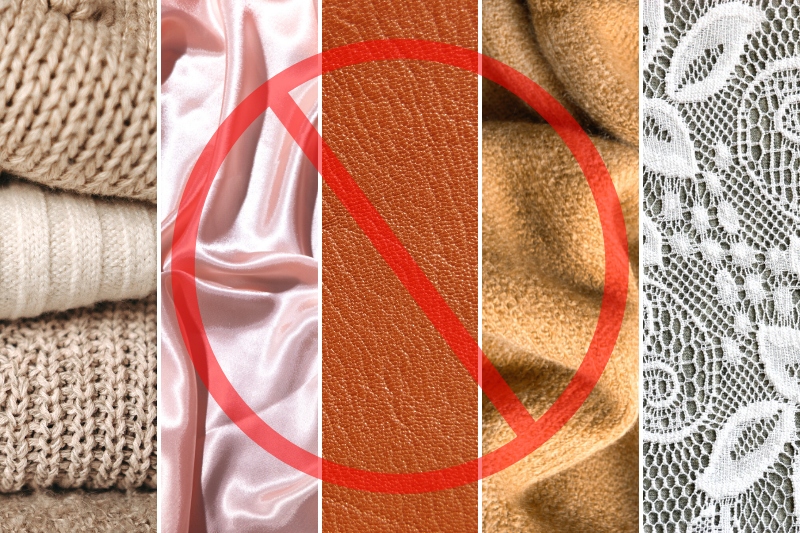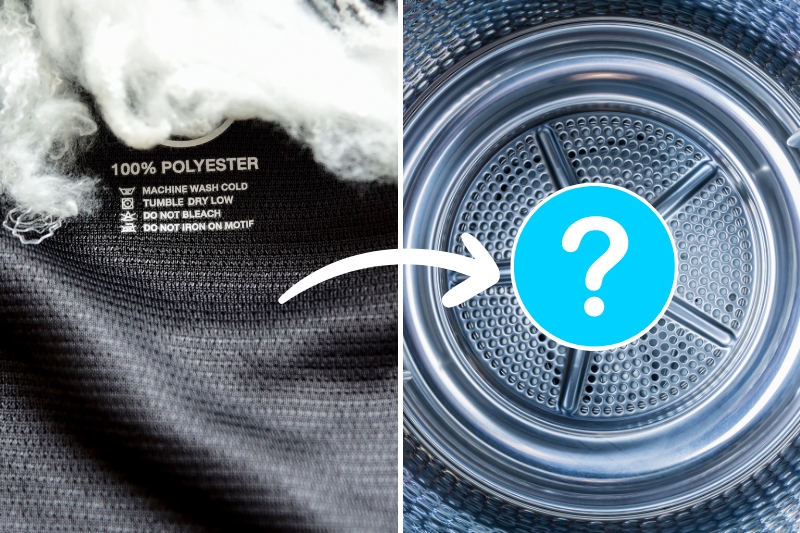In the early 2000s, polyester overtook cotton as the most popular fabric in the fashion industry due to its durability, versatility, and affordability.
As a result, it’s incredibly rare that you’ll now come across a wardrobe that doesn’t have at least a few polyester items inside.
Although polyester can safely be machine-washed, many people are still unsure how best to dry this fabric.
While tumble drying is a convenient and efficient way of drying your clothes, it can also ruin certain materials. So, can polyester be tumble dried?
The short answer to this question is yes! However, you must be careful to avoid damage or shrinkage, as polyester is very sensitive to heat.
Below, we go into detail on the best way to dry polyester so that you can prevent this accidental damage. Let’s get started!
Does Polyester Shrink If You Tumble Dry It?

Polyester can shrink in the tumble dryer. Although it’s a versatile material, polyester is more heat sensitive than other fabrics.
This increased heat sensitivity means that polyester can easily become damaged or shrunken if exposed to high temperatures.
As tumble dryers can reach temperatures of up to 70°C, it is possible to shrink polyester garments during the drying cycle!
Thankfully, this can easily be avoided by putting your tumble dryer on a low heat setting. It’s also important not to run the cycle too long.
We actually recommend removing polyester items from the tumble dryer while slightly damp, as this also prevents wrinkling (see below for more details).
How to Dry Polyester in the Tumble Dryer

Because polyester does have an increased sensitivity to heat, great care needs to be taken when drying these garments in the tumble dryer. Below are instructions to help you dry your polyester clothing without the risk of any damage.
We highly recommend you check each garment’s care label instructions before proceeding with the steps below to be safe.
If there are guidelines on the best heat setting and cycle length, always follow these instructions above others.
If there aren’t any specific guidelines, the steps below will help you to avoid any damage.
- Make sure clothes aren’t soaking wet – It is best not to put soaking wet clothes in a dryer, so remove any excess moisture using the washing machine’s spin cycle or by blotting clothes with a clean towel.
- Load dryer – Place your clothing in the dryer. If you only have one garment to dry, we suggest adding a few other items to help even out the weight in the drum.
- Choose the lowest heat setting – Set the tumble dryer to its lowest heat setting, which should be around 55°C. You can alternatively choose a no-heat setting that uses no heat whatsoever—your clothes are dried by the cool air as they’re rotated around the drum.
- Run the dryer – Let the dryer run for 30 minutes at a time until your clothing is nearly dry. Then, remove the slightly damp clothing and hang it up until it has finished drying completely.
Although you can continue to tumble dry your polyester clothing until completely dry, we suggest taking it out slightly early as per the above instructions. This will help to reduce wrinkles in the fabric and allows you to avoid over-drying.
If your polyester items often come out of the dryer with a large amount of static cling, you can also add a dryer sheet to the drum. This will make each garment more pleasant to wear and may help to reduce wrinkles as well.
Alternatives to Tumble Drying Polyester

Tumble drying your clothes may be convenient, but it’s not for everybody! Running an additional appliance will add to your energy bill and may take up space you don’t necessarily have spare.
It has also been shown that tumble dryers release microfibres into the air, which could cause respiratory problems.
If you wish to avoid this, you can simply air dry your polyester clothing using the instructions below:
- Hang your clothing evenly spaced on a washing line or clothes airer. You can even use a heated airer if you have one. There is no risk of shrinkage as heated airers don’t reach temperatures as high as in the tumble dryer—but they can help speed up the drying process.
- Check each garment every 2 to 3 hours to see if they are dry, turning each item over if needed so that the underside is exposed. As a quick-drying fabric, hanging your polyester clothes outside in the sunlight will also speed up the drying process to as little as 1 hour.
- Remove the clothing and iron out any wrinkles that have formed. As polyester is heat sensitive, remember to use a low heat setting on your iron.
Air drying clothing can be a time-consuming process. Although it isn’t overly taxing, this can be an issue if you need an item of clothing to dry in less than a few hours.
If you wish to speed up the drying process and don’t have access to a heated airer or sunlight, ensure that your clothing is placed in a well-ventilated area.
You can also remove any excess moisture from the garment before hanging it to dry by blotting the fabric with a clean, dry towel.
What Fabric Cannot Be Tumble Dried?

While many fabrics can safely be tumble dried, including polyester, some materials will become badly damaged when exposed to the high temperatures and increased agitation used in the machine. The fabrics that you need to be most careful with include:
- Wool
- Silk
- Rayon
- Leather
- Cashmere
- Lace
- Spandex
Even if a garment is not made of one of these fabrics, it is still a good idea to check the item’s care label before placing it in the tumble dryer. When in doubt, it is always best to air dry these items to avoid any potential damage or shrinkage.

Hannah has a passion for cleaning. She worked her way around Australia by cleaning hostels in exchange for free accommodation and used her cleaning skills to bag a job as a chalet host for a luxury ski company in France.






